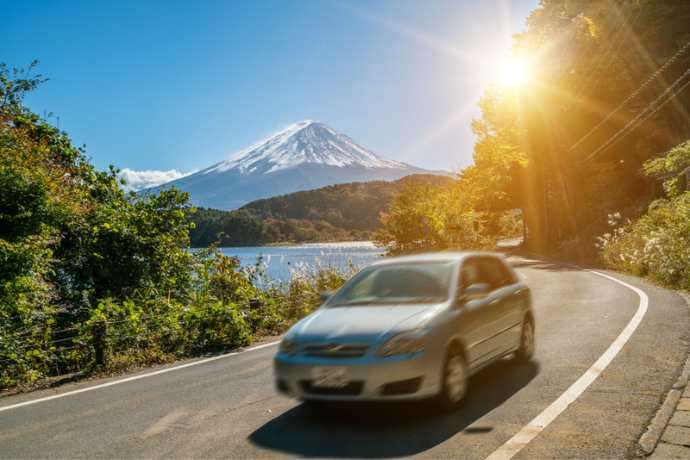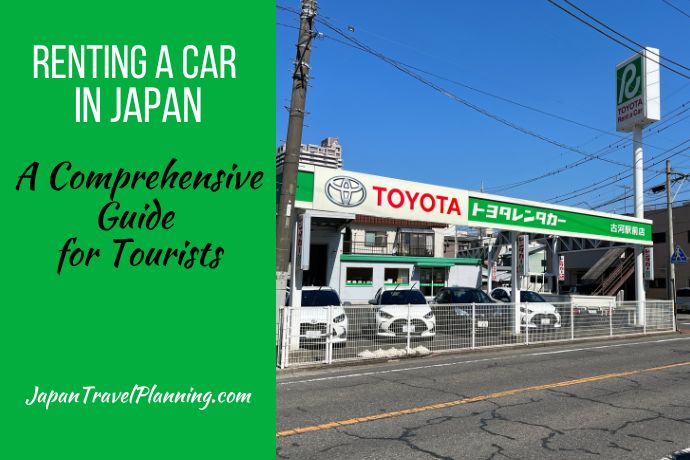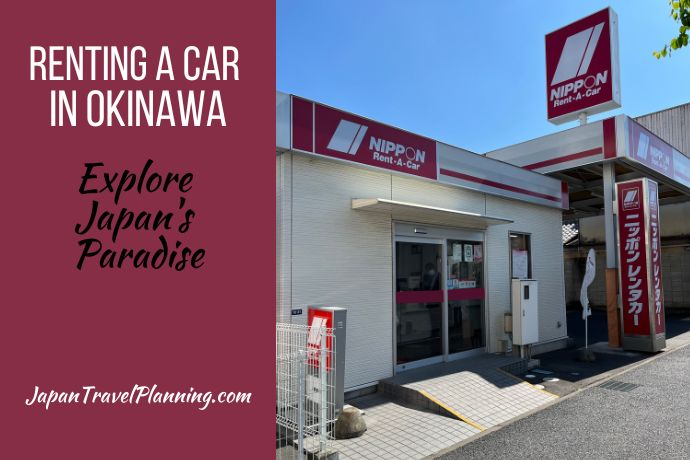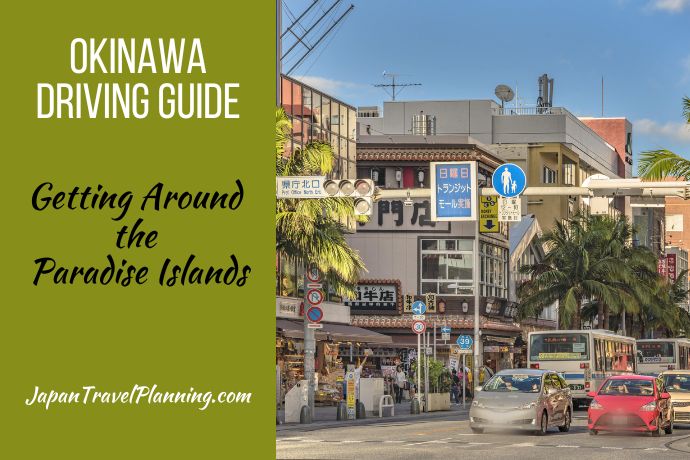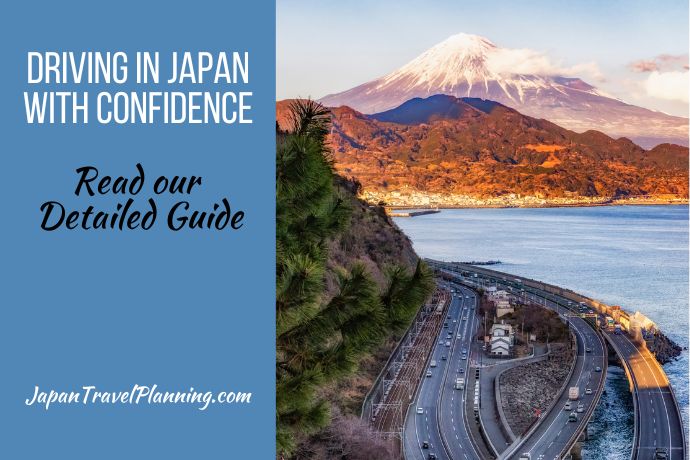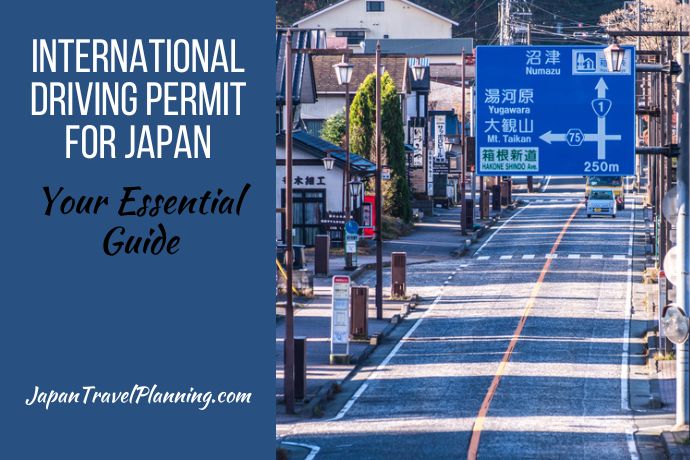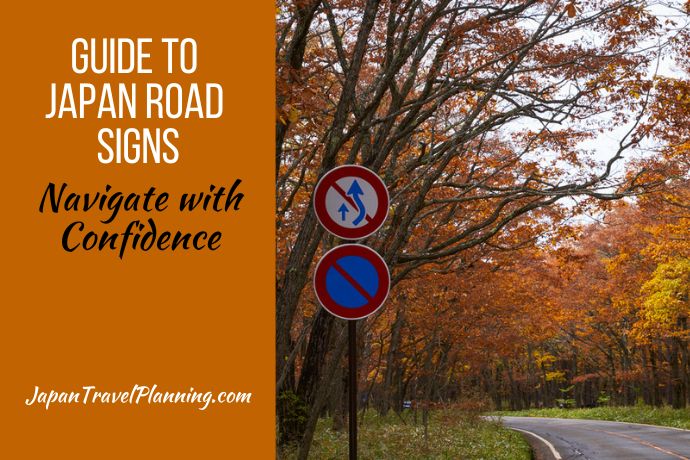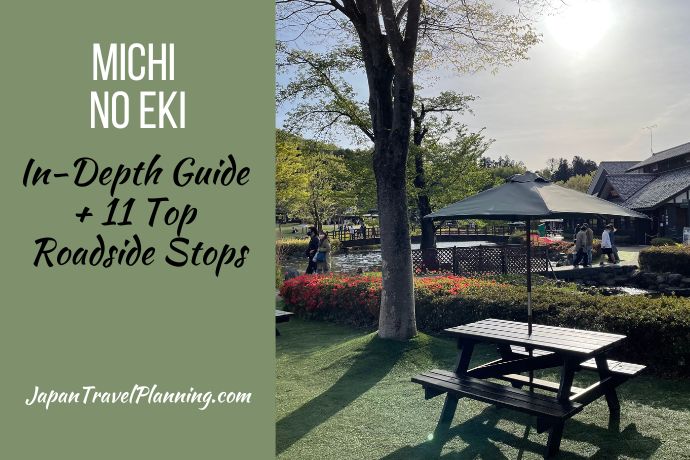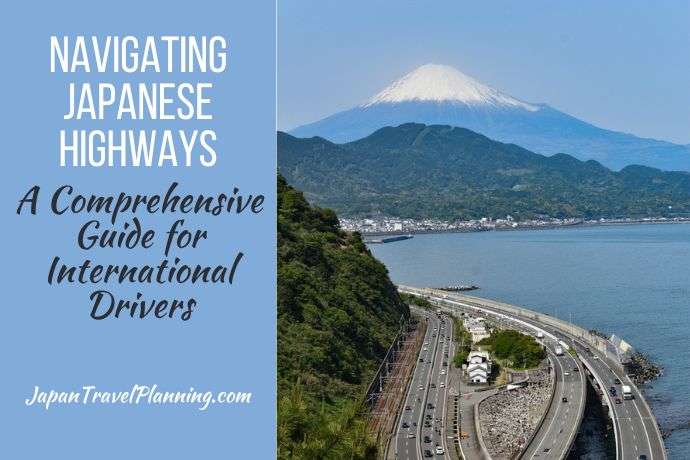When you need to visit the bathroom but run into a farmers market; when you are looking for a cheap restaurant but land in a souvenir shop with locally produced goods; when your kids want to play but you discover you can park your RV overnight. That is when you have found a Michi no Eki, one of the unique places that dot the back roads of Japan.
When my family travels on day trips and weekend journeys in Japan, we often stop at a Michi no Eki. They are all different, and while they all have a few things in common, each is a discovery.
In the rest of this article, I’ll take you through the ins and outs of these distinct roadside stations and highlight 11 noteworthy Michi no Eki you’ll want to experience for yourself.
Disclaimer: This article contains affiliate links. If you book after clicking on one of these links then we may receive a small commission at no extra cost to you.
- Easy comparison of multiple car rental provider options using ToCoo!
- Use coupon code K49O12 to get your 1,000 yen discount
- ToCoo! is a local Japanese car comparison site that has the most options available
- Clear description of included protection and excess
- Good cancellation options
- Child seats, GPS, electronic toll cards, second driver and more are available as add-ons
Introduction to Michi no Eki
Michi no Eki (道の駅 in Japanese) translates as ‘roadside station’ or ‘rest stop’. However, Michi no Eki are much more than just a place to go to the toilet, stretch your legs and grab a bite to eat.
On April 22, 1993, the first 103 Michi no Eki were officially registered with the Japanese government. 2023 is the 30th year of Michi no Eki, and their number has grown more than tenfold since then.
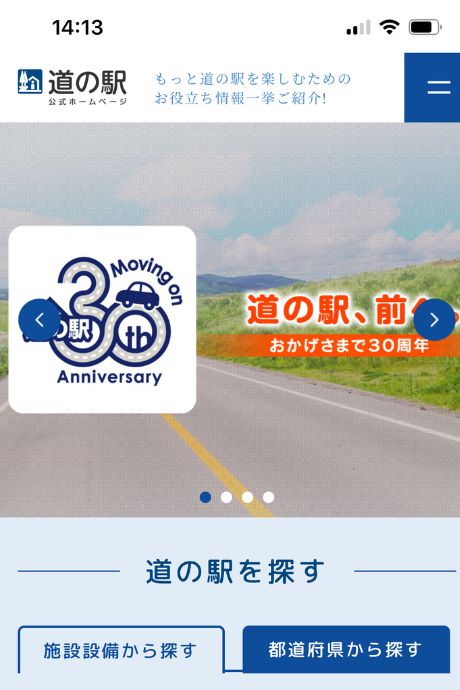
There are 1209 government-designated Michi no Eki in Japan in 2023, and new Michi no Eki are constantly added. ‘Government-designated’ means they are members of the Michi no Eki Association, a government-supported body.
The chance that you will find one if you drive through the Japanese countryside is high, as one of their functions is to promote local tourism. You will normally find them on big national roads, but not the expressways, which have service areas that fill many of the same functions.
What Do Michi no Eki Offer, and Why Are They Worth Visiting?
In late 2007, the first Michi no Eki opened in Tokyo prefecture, which means there are now Michi no Eki in all 47 prefectures of Japan.
Michi no Eki were a government initiative created since there were no rest stops on ordinary roads.
The expressways, which by then connected all parts of Japan’s main islands, had service areas for the convenience of drivers. However, there was nothing similar on local roads, which meant truck drivers who had to take their mandated rest had nowhere to stop.
To register as a Michi no Eki, you need to have three things:
- A 24-hour free parking lot
- Restrooms and other rest facilities
- Provide information services, including information about the local area and other information for travellers, such as emergency medical information.
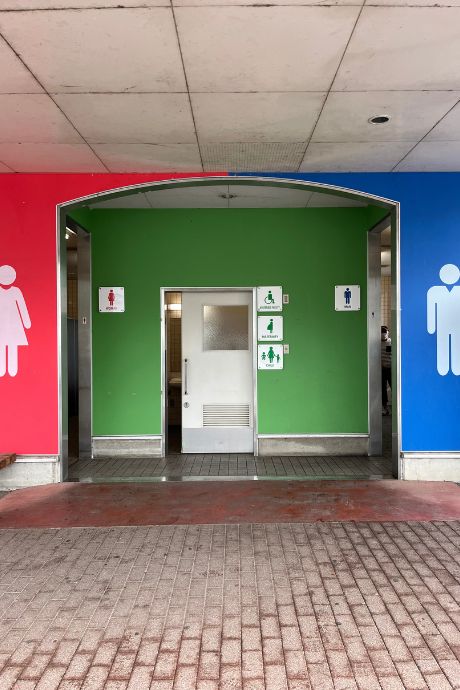
Cultural Insights and Tourism Information
Michi no Eki were originally meant to be a rest stop for truck drivers, but the information function quickly surpassed its original purpose. This was intended to help truck drivers navigate the area easily when finding their way meant finding it on a paper map.
As GPS and car navigation systems became the norm, asking your way became outdated. Instead, the local tourist information at the Michi no Eki became what customers requested.
Initially, the local information at the Michi no Eki might have just been information signs about the neighbourhood. Soon after, information stands staffed by volunteers or the farmers’ market staff became the norm.
It is a very rare location in Japan that has not been visited by a historical figure or where there is some natural wonder. At times, they may be made by humans, like the Inakadate rice field picture displays in Aomori, made especially to be seen from the Michi no Eki. Other places have remarkable temples or shrines with more than two thousand years of history.
Some roadside stations take their local history more seriously than others, with small museums displaying the local history. Mostly, the information is in Japanese, although occasionally, you can find brochures in English. Also, finding someone who speaks English at most Michi no Eki is more luck and happenstance.
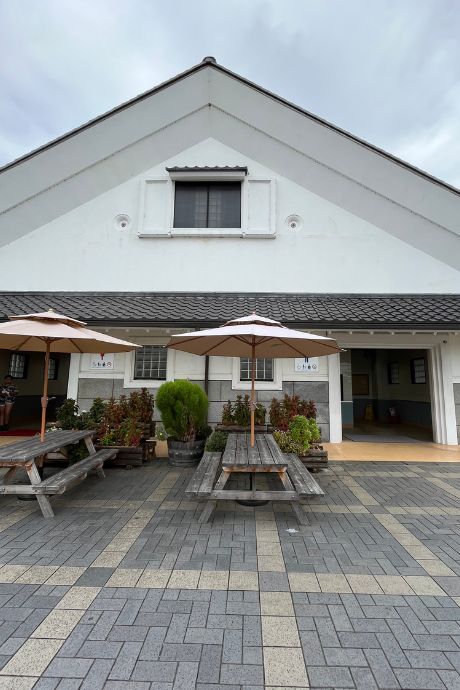
Rest and Relaxation
In our old car, the navigation system told us to consider taking a break every two hours. If you have travelled with children – or the elderly – you know that two hours is often much longer than they need between breaks, unless they are asleep.
In Japan, even if all the passengers are adults, driving time between stops will usually be less than an hour. Japan is densely populated with sights, and unless you are in Hokkaido, finding a place where you have to drive more than an hour between places with something visit-worthy on offer is very rare.
You may not want to stop at every Michi no Eki you come across, but consider stopping regularly for a short break. Driving on the small local roads can be much more demanding than going on the expressway.
A unique feature of the Michi no Eki parking lots is that they are open 24 hours a day. Most parking lots are off-limits after closing in a country where almost all land is private and subject to the rules posted by stores and other property owners. However, you can stop all night at the Michi no Eki parking lots.
Trucks tend to fill up the large parking spaces at night (they are often replaced by tour buses during the day). But there are usually quite a few ordinary car-sized parking lots.
Many drivers who get a late start tend to use these to nap. The parking lots at the Michi no Eki are also increasingly attracting another group of travellers: families in RVs (or campervans).
It is free to park at the Michi no Eki, and the availability of 24-hour parking makes it a great stopover place for anyone who needs to sleep for a few hours or overnight.
Because people are sometimes sleeping, you need to keep your noise level down, tricky though it may be with small kids.
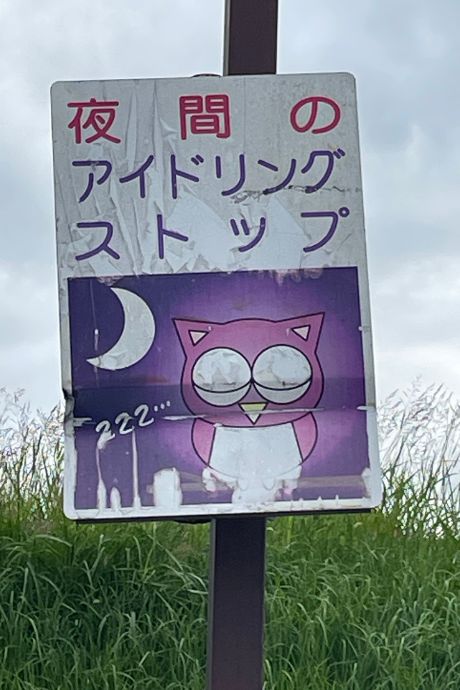
Usually, toilets are as far as the conveniences go. There are usually no areas to sit down and lounge about – seating is mostly part of the restaurants. Nor are there showers or laundromats.
There are a few Michi no Eki with hot spring baths (even more in the vicinity of them), but that is not the norm, even if they are worth seeking out.
Other Facilities and Services
Since a Michi no Eki is not controlled by the expressway company, like service areas, they have developed differently.
Like the service areas, some of them have become destinations in their own right. Many have set up playgrounds, making themselves more attractive to parents with children.
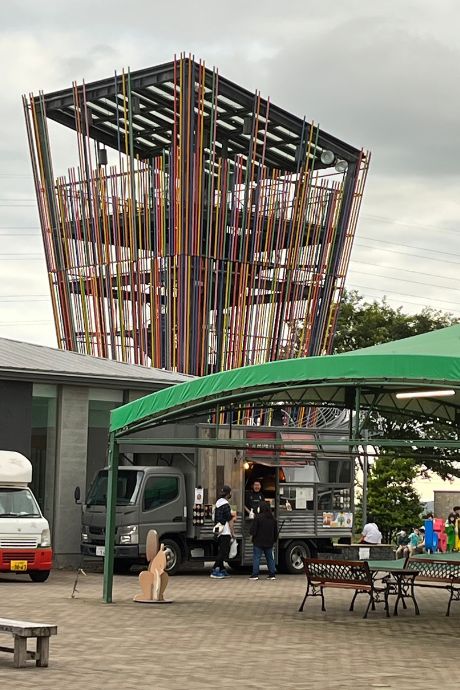
Michi no Eki also took on new functions as they became established. In addition to offering toilets, information services, parking and playgrounds, a Michi No Eki typically offers three other services:
- a farmers market selling vegetables and other produce,
- a restaurant (often serving regional delicacies), and
- a bussanten/bussankan (a store with local specialities).
The Michi no Eki were created to cater to customers in cars, but lately, they have started to get a different set of customers: cyclists.
As cycling has become increasingly popular in Japan, bike riders have become frequent visitors to the Michi no Eki (within 60 kilometres of bigger cities). They are particularly popular on weekends and while the weather is nice.
Local Produce and Goods
Michi no Eki quickly went from providing information about the local specialty produce and goods to offering them. They became like farmers’ markets.
In Japan, an ecological hotspot with hundreds of indigenous, sometimes hyperlocal species, there is enormous variation in what is offered in a Michi no Eki. For example:
- In Izu, there are drinks made from a fruit that only grows in the local mountains.
- In Hokkaido, the shelves are filled with anything made from haskap (honeyberry) fills the shelves.
Michi no Eki can be a constant source of innovation. To illustrate, a farmer in Ibaraki might grow ‘hitomebore’ rice from Miyagi one year. Next year, the local miso maker will develop a curry miso, which is especially good with hitomebore. Next year, the local tea shop finds a kind of nori that goes well with curry miso on hitomebore rice.
Visiting travellers gladly purchase and bring home those local inventions until they become so popular that other makers start producing them, and they gradually eat themselves into the Japanese culinary culture.
The Michi no Eki are more than places to find the latest local inventions. As inflation has struck Japan, the farmers’ markets have taken on new importance.
The markets at the Michi no Eki are supplied directly by the farmers and not through Japan Agriculture (JA), the farmers’ cooperative, which otherwise has a monopoly on distributing vegetables and rice to grocery stores.
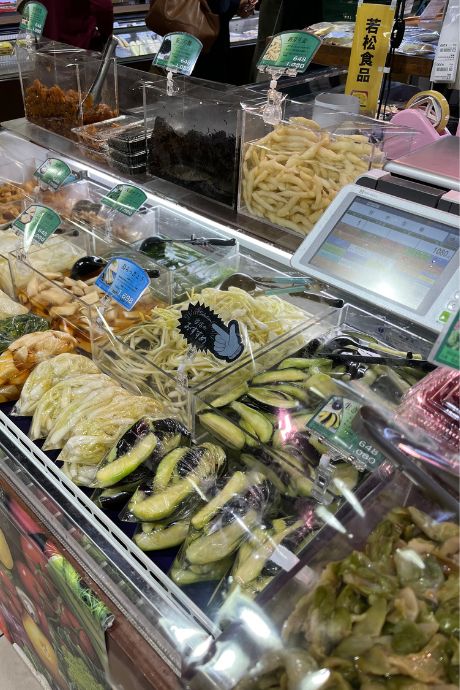
The farmers can provide varieties they have grown out of love or interest rather than the standard demanded by JA. Since they bypass an intermediary, the prices are lower than in the supermarkets, and since they are personally responsible, the quality is higher.
This, however, means that at opening time, the locals flock to the Michi no Eki to stock up on cheap local produce. Mornings can be very crowded in the farmers market section.
Restaurant Experiences
The restaurants at Michi no Eki vary from simple to high cuisine. Typical offerings are soul food such as ramen, udon, soba, and kats-kare. You make your order – and payment – in a ticket machine at the entrance. Usually, in Japanese restaurants, there are pictures, or even more illustrative plastic models, showing the food.
There is often (but not always) a row of snack stands serving Japanese fast foods like karaage (fried chicken), deep-fried squid rings, and corn dogs.
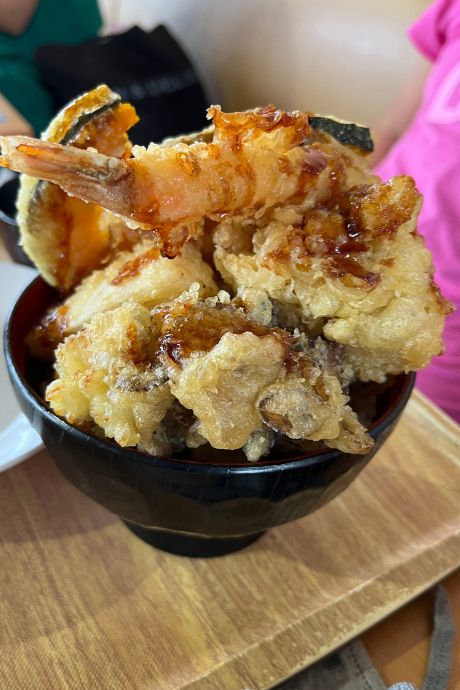
Try ‘konyakku’ balls if you see them. It is a specialty in the northern parts of Japan and the only snack you will find anywhere that makes you lose weight. But beware of the mustard, which is Chinese-style and very spicy.
In winter, a glass of ‘amazake’ will warm you up. It is made from the malted rice used to brew sake, but before it is fermented. It contains no alcohol and is a safe drink for drivers.
In some Michi no Eki, the restaurants are more fancy. There can be anything from teppanyaki restaurants by Michelin-starred chefs to Italian restaurants featuring pizza made with local vegetables.
Often, the restaurants feature local dishes, even if the offering tends to the soul food version.
The lines can be long at places serving something special, especially on the seaside where the seafood bowls (kaizen don, 海鮮丼) are snapped up as soon as the chefs can make them and often sell out before the ordinary lunchtime starts.
Fresh and Unique Souvenirs
There are few places in Japan where you will find the tourist shops typical of other countries, full of souvenirs such as plastic knick-knacks painted with the name of the local sight. There is usually a stand of such souvenirs, but they are typically small.

Instead, Michi no Eki serve as a bussanten. Bussanten means a product exhibition, a store for local products and produce. You might also see the term ‘bussankan’, which translates as a product hall.
Practically, they both translate as ‘souvenir shop’, but emphasise local goods and products. Most often, this means local food specialties since even the smallest city – even village – will have its signature dish.
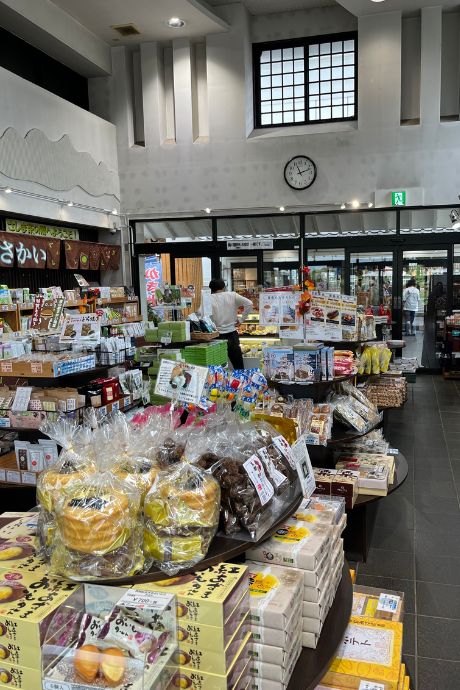
In farming areas, especially in mountainous regions with milk production, this means cheese, cream, butter, and ice cream. Where there are strong local industries producing ceramics, wood products, and clothes, they will often be featured in the business as well.
It is always worth checking out what is on offer. Even if there are occasional stands of souvenirs leaning in the more traditional direction, the unique souvenirs are those that showcase the local industries, who often put samples of their products in the business. After all, it is free advertising, and if someone buys a product, it is both validation and profit at the same time.
Events
Another function filled by some Michi no Eki is to act as a venue for events.
Most Japanese cities do not have space for big events or concerts, bar the occasional festival around the local shrine. When the Michi no Eki puts on events, it makes a perfect location for them.
A Michi no Eki usually has no built-up stage, but their open spaces are perfect for local performers such as buskers, local magicians or living statues.
Differentiating Michi No Eki
Although Michi no Eki exist to support motorised tourism, there are many things they don’t have, including locations on the expressways and gasoline stations.
Following is a quick look at how Michi no Eki compare to gas stations, service areas and dedicated bussankan/bussanten.
Michi no Eki vs Gas Stations
Michi no Eki are normally located near attractive sights. This means they are slightly off the main roads. That makes Michi no Eki less relevant for those who just aim to pass through – and is one of the main reasons they do not have gasoline stands.
In many cases, especially with Michi no Eki near the expressway entrance, there will be one or more gas stations nearby. But they are not part of the Michi no Eki, and there are no parking spaces at the gasoline stands.
Michi no Eki vs Service Areas
On the expressways, the service areas fulfil much of the same functions as the Michi no Eki on ordinary roads.
They typically have a gasoline stand and often a convenience store. Their parking lots are open 24 hours a day, even if the services in the service area (except for the toilets) shut down in the evening.
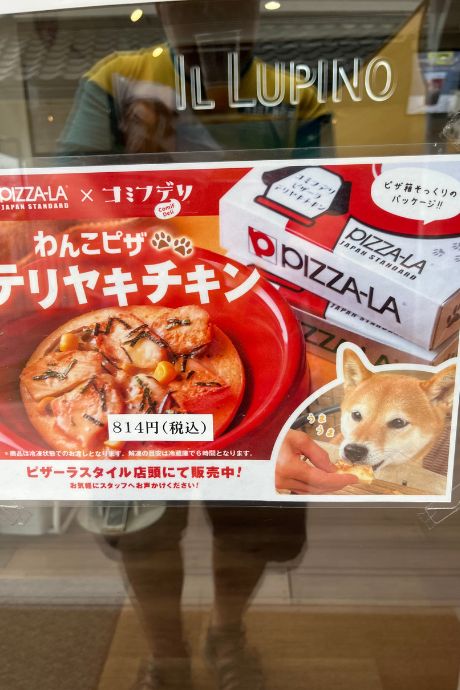
Michi no Eki vs Bussankan
The contents of a stand-alone bussankan are similar to what you would find at a bussankan in a Michi no Eki, possibly with less focus on edible souvenirs.
There is usually no farmers market at the bussankan in city centres and no restaurants. The focus is exclusively on the local products, often with a craft focus.
It might also be hard to find parking near stand-alone bussankan.
Notable Michi no Eki Across Japan
The best Michi no Eki is the one closest to you. But in Japan, a land where tourist guidebooks already ranked famous sights as early as the 18th century, there are plenty of lists of the best, most wonderful, or most interesting Michi no Eki.
You could make separate lists detailing the Michi no Eki with microbreweries, the ones with onsen, or those with the best sea view.
Here is a combined list of the Michi no Eki that consistently are near the top in the rankings. Double-check the opening hours before you visit one as visiting hours can change.
1. Michi no Eki Kawaba Den-en Plaza, Gunma
It is hard to believe this is a Michi no Eki. It is far enough away from the main roads to be a holiday village.
The stores and restaurants are spread out in traditional buildings around a pond, complete with ducks.
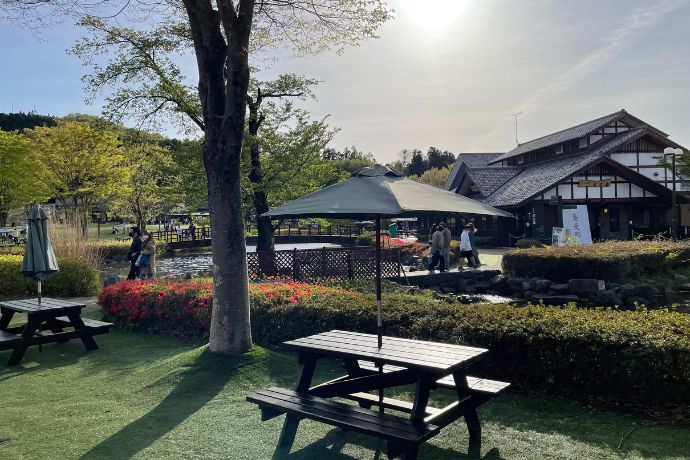
A children’s play area has an all-year sledding slope (on artificial grass) and a zipline into the nearby forest.
This Michi no Eki builds heavily on the surrounding farms – as is common in highland areas. Milk production is a significant industry, turned into luscious cream, delectable ice cream, and tasty cheeses, Italian style. There are fresh blueberries from the nearby farms and the fruit and vegetables you will usually find in any agricultural area.
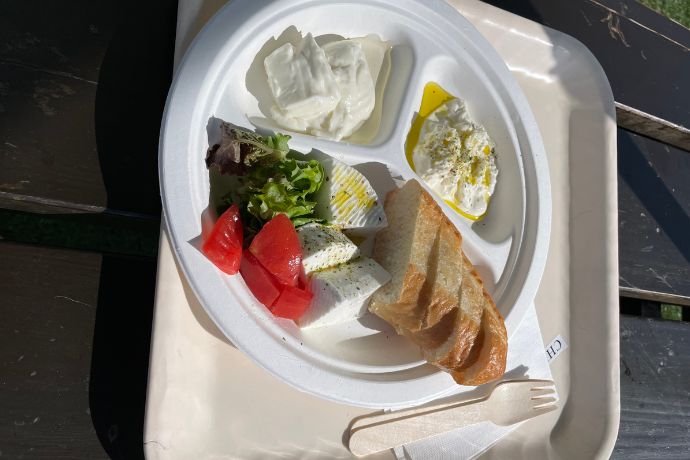
A microbrewery completes the picture, although the restaurants tend towards traditional fare rather than European cuisine. This being the mountains, the soba is an experience, however.
The farmers market only takes cash, but the restaurants and some of the shops take credit cards.
Address: 385 Hagimuro, Kawaba, Tone District, Gunma 378-0111 (〒378-0111 群馬県利根郡川場村萩室385)
Website: Kawaba Den-en Plaza
Opening hours: 9 am – 6 pm
2. Michi no Eki Fujiyoshida, Araya, Yamanashi
This Michi no Eki is famous for its views of Mt Fuji, but that is not the only thing you can find here. Apart from the usual restaurants and farmers market, there is a sports arena and a huge indoor playground for children (which is not free, but that you have to pay for).
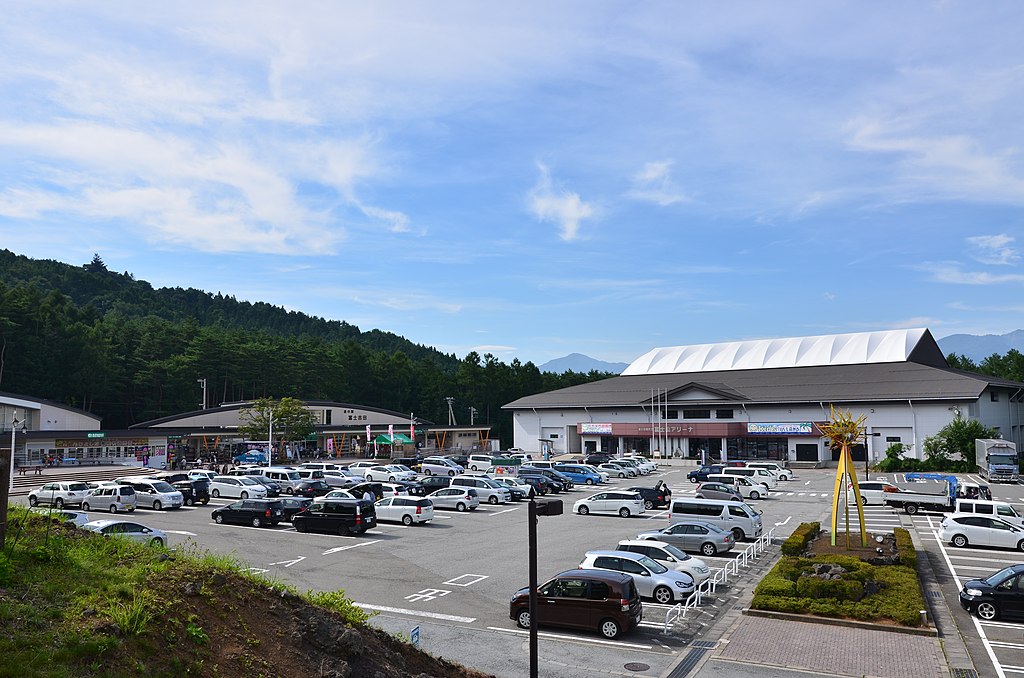
KΛNΛTΛ, CC BY-SA 3.0, via Wikimedia Commons
If you have brought your water bottle (or an RV with a water tank), you can also fill it up from the nearby water fountain. Mt Fuji is a source of spiritual power, and it is water as well. It is also extraordinarily clean and contains useful minerals.
Next to the Michi no Eki is an even more interesting attraction: The Fuji Radar Dome Museum. Since the weather changes quickly in Japan, there used to be observation stations on Mt Fuji. However, the climate on top of the mountain is too hazardous, even for well-prepared meteorologists.
When weather observations started to use radar, the weather radar was built here, where electricity and other infrastructure were available. But as weather observations have begun to use satellites, weather radars became less relevant, so it is now a museum.
Address: 〒403-0006 Yamanashi, Fujiyoshida, Araya, 3-chome−7−3 (〒403-0006 山梨県富士吉田市新屋 3丁目7−3)
Website: Michi No Eki Fujiyoshida
Opening hours: The rest area services are open 8:30 am – 7 pm from July to September, 9 am – 7 pm from April to June, October to November, and 9 am – 6 pm from December to March. From July to September, the restaurants are open 9 am – 6 pm, and the rest of the year from 10 am – 5 pm.
3. Michi no Eki Itoman, Okinawa
As you travel south from the Okinawa capital of Naha, you pass the main fishing harbour of the island. Itoman is just south of Naha Airport, where most fishermen in the prefecture land their catches.
The road station in Itoman is unusual because of the location. They have plenty of vegetables in the farmers market, but there is also a butcher shop – and two large fish markets. The Japan Fishermen’s Association runs one, and the Michi no Eki operates the other. The vegetable market also has a large fish section.
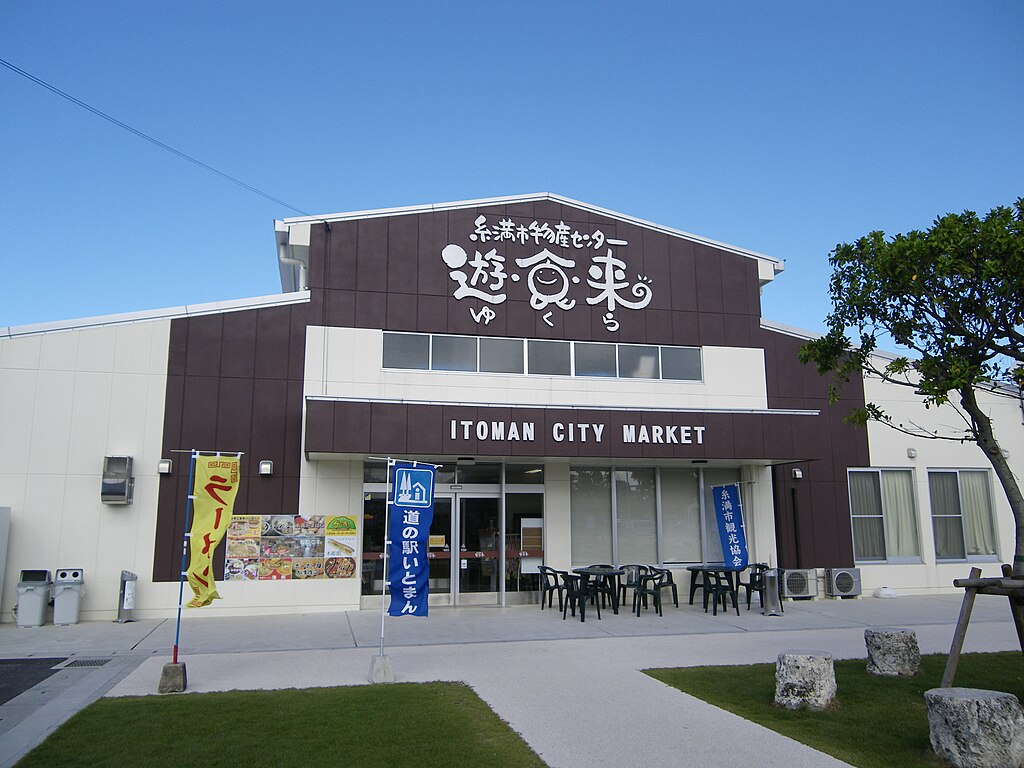
Kugel, Public domain, via Wikimedia Commons
You can not bring fresh fish home for a souvenir, but there are plenty of fish preparations to bring home (cans are fine if you put them in checked luggage). The fresh fish dishes are perfect for lunch in the nearby park.
Take a look at the Arts & Crafts Center museum after lunch.
Address: 4-chome-19-1 Nishizaki-cho, Itoman, Okinawa 901-0305 (〒901-0306 沖縄県糸満市西崎町4丁目20)
Website: N/A
Opening hours: 9 am – 6 pm
4. Michi no Eki Utsunomiya Romantic Village, Tochigi
One of the earliest and still most prominent Michi no Eki, is the Romantic Mura in northern Tochigi.

There is the usual farmers market with locally grown vegetables, and there is also a huge greenhouse where they grow fruit and vegetables that usually grow less well in northern Tochigi.
Since this is a hot spring area, there is an onsen – and a huge spa with heated swimming pools (that cost extra).
There is also a microbrewery that brews beer for local consumption, some of it from leftover bread instead of malt, making for a beer that is slightly toasted but which still tastes similar to a traditionally brewed beer.
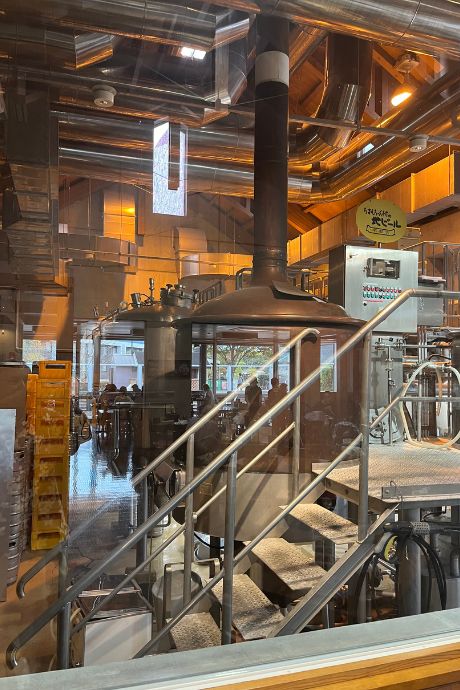
Address: Hei-254 Nissatomachi, Utsunomiya, Tochigi 321-2118 (〒321-2118 栃木県宇都宮市新里町丙254)
Website: Michi no Eki Utsunomiya Romantic Village
Opening hours: 8:30 am – 5 pm (6 pm on weekends).
5. Niseko View Plaza, Hokkaido
Hokkaido is a huge island, but the snow resorts and the tallest mountains are concentrated at the island’s southern tip.
Niseko is one of the most famous resort areas, and the Michi no Eki in Niseko has fantastic Hokkaido ice cream. The hot snack stands offer potato products, which are area specialities.
But the best part of Niseko View Plaza is the mountain views. You have beautiful views of the mountains in all directions, especially of Mt Yotei. And the tourist information is excellent, with large parts in English.
Address: 77-10 Motomachi, Niseko, Abuta District, Hokkaido 048-1544 (〒048-1544 北海道虻田郡ニセコ町元町77-10)
Website: Niseko View Plaza
Opening times: 9 am – 6 pm
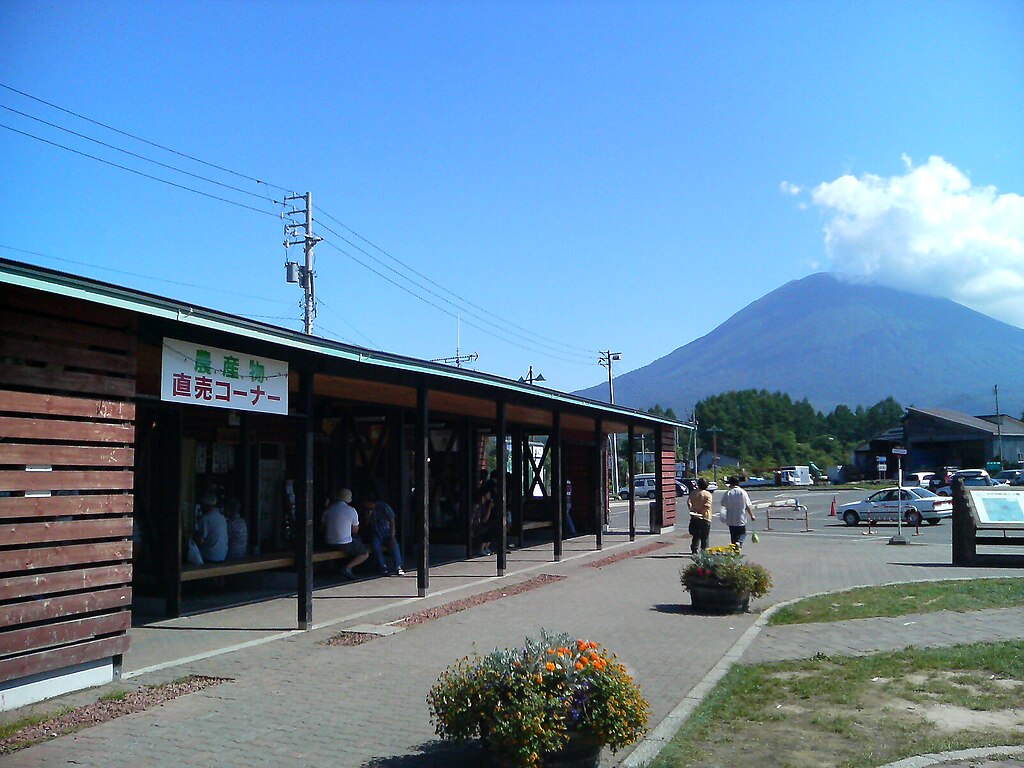
Oga, CC BY-SA 3.0, via Wikimedia Commons
6. Awaji Michi no Eki, Hyogo
The claim to fame of this Michi no Eki is its location under the bridgehead of the Akashi Kaikyo bridge, the second longest suspension bridge in the world, and the longest when it was completed in 1998.
The bridge is an important thoroughfare connecting Awaji Island with the city of Kobe and, beyond that, with the island of Shikoku.

The strait it crosses is famous for being treacherous, with cross-currents, and being the scene of several ferry disasters before the bridge was built.
The restaurants naturally feature local delicacies, especially the onions for which the island of Awaji is famous, but also staples from the region.
Address: 1873-1 Iwaya, Awaji, Hyogo 656-2401 (〒656-2401 兵庫県淡路市岩屋1873-1)
Website: Awaji Michi no Eki
Opening hours: 9:30 am – 5 pm (7 pm on weekends).
7. Michi no Eki Shodoshima Olive Park, Kagawa, Shikoku
The climate of Japan ranges from the tropical in the Yaoyama islands to the subarctic in Hokkaido. But a large part of Japan has a Mediterranean climate.
It is possible to grow grapes over most of the country, but while olive trees are commonly found in gardens, there are few olive plantations.
However, you will find them on the island of Shikoku, surrounding a small Greek-style windmill – and a Michi no Eki.
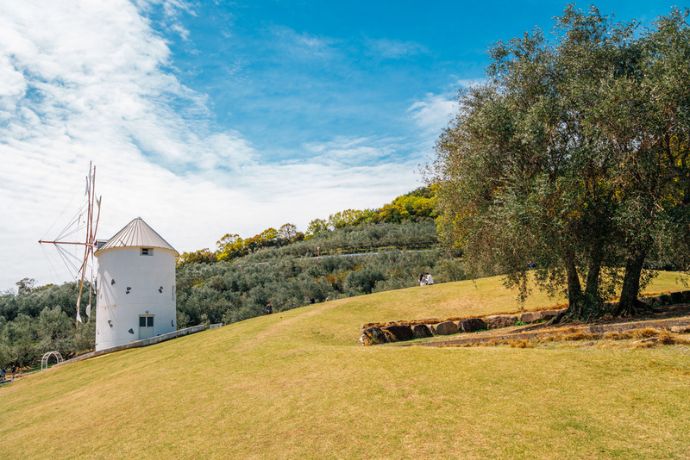
Not surprisingly, the bussanten bulges with locally produced olive oils, pickled olives, olive foccacia, olive soap, and anything you can imagine that you can put olive oil in.
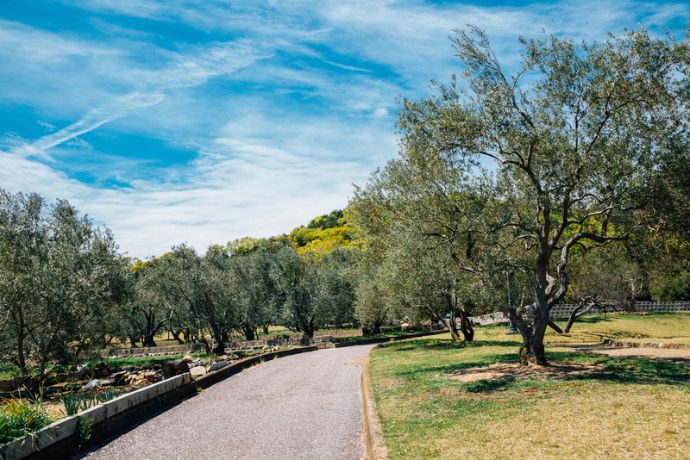
You can also buy local wine. This may be the only place in the world where you can buy locally grown and produced olive oil alongside locally produced eiswein – made when the grapes freeze. But not long enough to kill the olives. It is also one of the few places in Japan where you can get olive-flavored ice cream.
Address: 〒761-4434 Kagawa, Shozu District, Shodoshima, Nishimura, 甲1941-1 (小豆島町西村甲1941-1)
Website: Michi no Eki Shodoshima Olive Park
Opening hours: 8:30 am – 5 pm
8. Michi no Eki Inakadate, Aomori
For 30 years – starting in 1993 – the village of Inakadate in Aomori has had a unique art form on display from July to September. By planting different kinds of rice in the fields around the village, the farmers can paint different kinds of pictures using the rice fields as a living canvas.
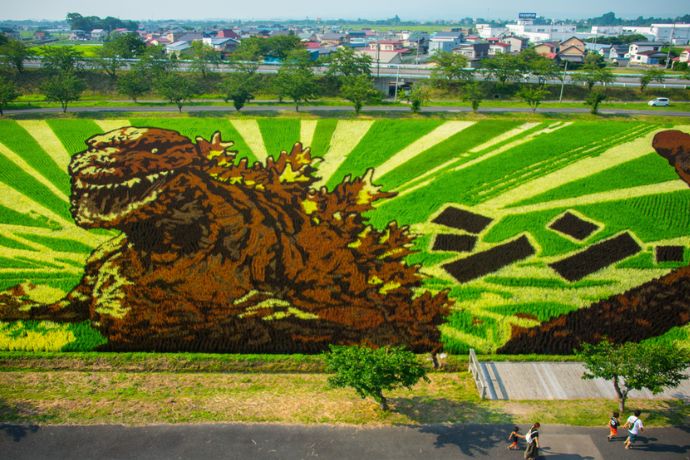
The event draws hundreds of thousands of visitors every year. While the train station next to the fields has been renamed Tambo Art Station, the view is no less good from the Michi no Eki, where you will get an excellent overview from the observation tower.
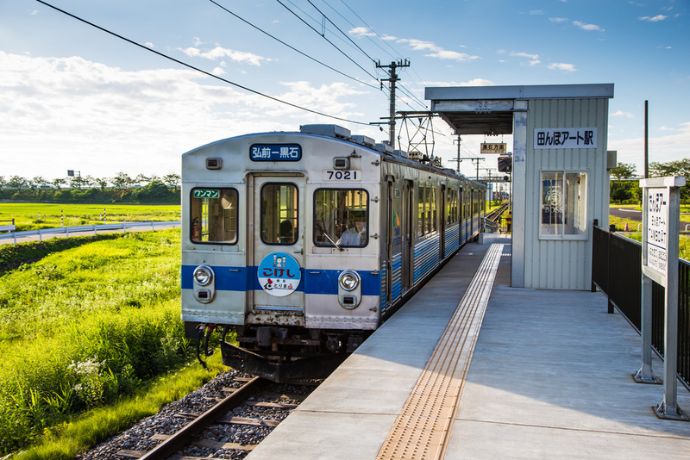
In winter, when the fields are covered in snow, the pictures are drawn using footsteps in the snow, made by local volunteers.
The Michi no Eki Inakadate ‘Yayoi no Sato’ offers more than an observation tower. There is also a playground for the kids and mini golf as a family activity. It also has the usual restaurants and farmers market.
Address: Yahata-10-10 Takahi, Inakadate, Minamitsugaru District, Aomori 038-1111 (〒038-1111 青森県南津軽郡田舎館村高樋八幡10−10
Website: Michi no Eki Inakadate
Opening hours: 8:30 am – 6 pm (playground and restaurant closes earlier, last order for the restaurant is at 3:30 pm). From December to March, it closes at 5:30 pm.
9. Michi no Eki Munakata, Fukuoka
The Michi no Eki in Munakata is located next to the Munakata city harbour – with catches delivered directly to the market and the Michi no Eki restaurants. This is a good thing because, as a visiting traveller, you can not take fresh fish with you.
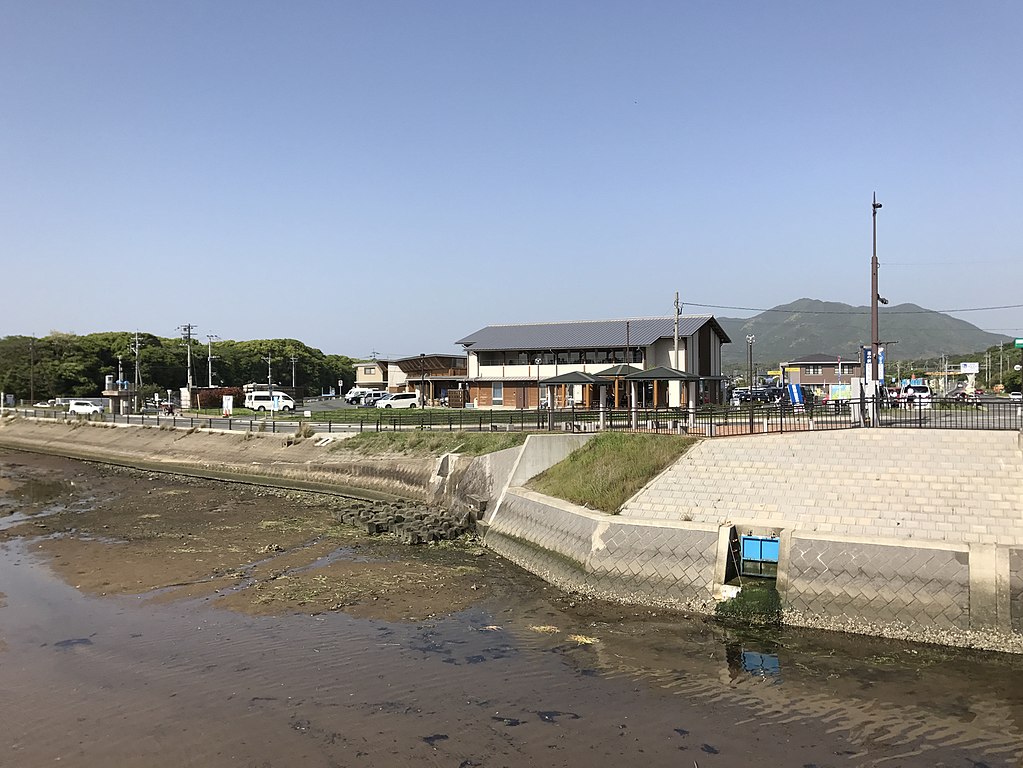
そらみみ, CC BY-SA 4.0, via Wikimedia Commons
The Munakata Michi no Eki is famous for its fish dishes. Fresh fish from the sea is hard to spoil in the kitchen, and a talented chef will make it even better. Especially since they also have fresh ingredients from the sea to play around with.
The buildings in themselves are worth stopping at. They are a perfect example of modern Japanese wood architecture, creating an open, warm space, especially around the farmers market.
Address: 1172 Eguchi, Munakata, Fukuoka 811-3502 (〒811-3502 福岡県宗像市江口1172)
Website: Michi no Eki Munakata
Opening hours: 9 am – 5 pm
10. Minato Oasis Uwajima Kisaiya Square, Ehime
Ehime is famous for its mikan mandarin oranges, and in season, this Michi no Eki overflows with them.
It is also located almost directly at the Uwajima harbour, meaning the market and food court also feature abundant local seafood. In particular, the kaizen-don, seafood on rice, draws visitors from far away (if you check the number plates of the cars in the parking lot).
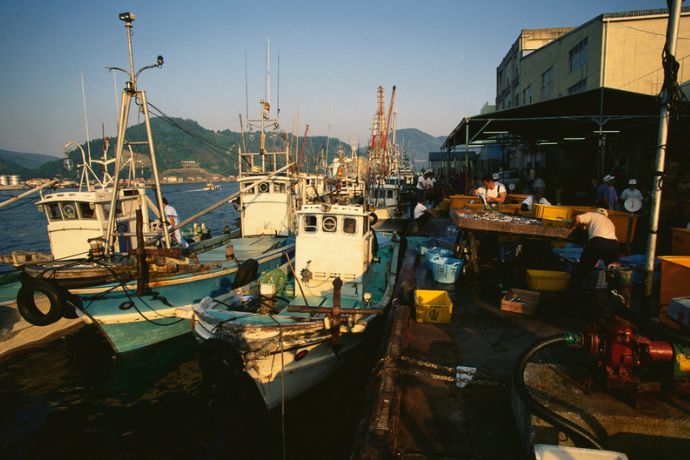
The Uwajima Michi no Eki not only gives you a view of the sea, but you can also glimpse the Uwajima castle on top of the city’s hills. The castle was destroyed during the 19th century, but the donjon from the 16th century remains and has been turned into a small museum.
Address: 〒798-0006 Ehime, Uwajima, Bentencho, 1丁目318−16 (〒798-0006 愛媛県宇和島市弁天町1丁目318−16)
Website: Minato Oasis Uwajima Kisaiya Square
Opening hours: 9 am – 6 pm; restaurant is 10 am – 6 pm, with the last order at 5:30 pm
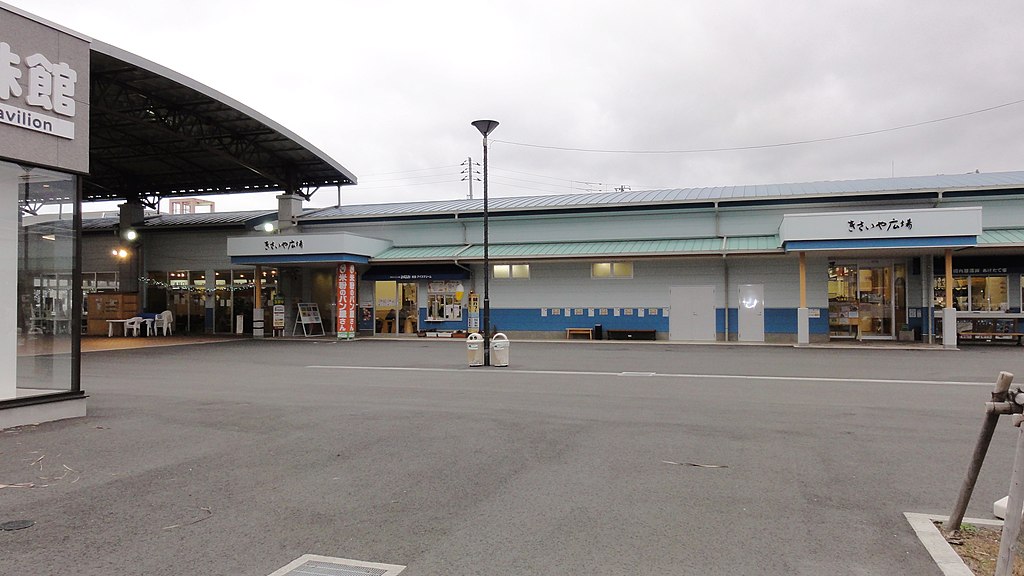
アラツク, CC BY-SA 4.0, via Wikimedia Commons
11. Michi no Eki Sakai, Sashima, Ibaraki
This Michi no Eki is my personal favourite, not only because of the traditional design but also because of the Sekiyado Castle museum on the other side of the Tone River.
It makes for a nice day trip from the Tokyo area. You can rent a car in Koga on the Utsunomiya line (one hour from Ueno) or in Kasukabe (home of cartoon character Crayon Shin-chan) on the Tobu Skytree line and then drive to the Michi no Eki.
The parking at the Michi no Eki is limited, but the shopping centre on the other side has a huge amount of parking. There is also a lovely and not too-crowded onsen on top of the Don Quijote store.
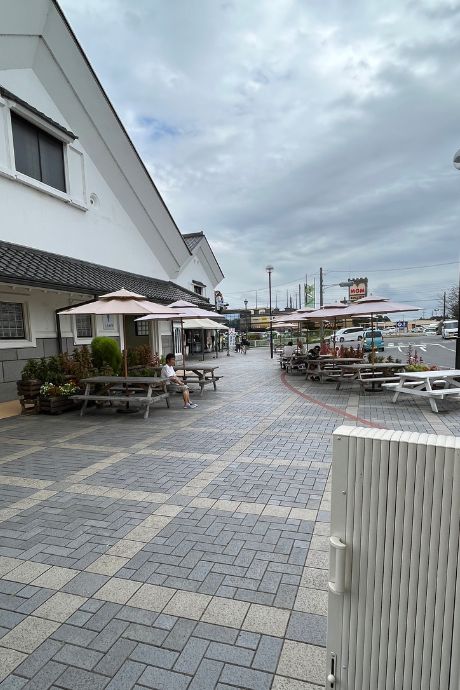
The farmers market is nice but not too large and offers something not sold in many other Michi no Eki: wine from the local winery made from grapes grown in the area.
The beer from the microbrewery at the entrance (probably the smallest you have ever seen) is excellent, and the restaurants – especially the sandwich shop – are a culinary step above what you will find at other Michi no Eki.
The restaurants and the shop take both cash and credit cards, except the microbrewery, which only takes cash.
Address: 1341-1, Sakai, Sashima District, Ibaraki 306-0433 (〒306-0433 茨城県猿島郡境町1341-1)
Website: Michi no Eki Sakai
Opening hours: 9 am – 6 pm
Tips for Visiting a Michi no Eki
Here are some tips about the best times to visit Michi no Eki, how to find your way around them, and the payment methods at Michi no Eki.
Best Times to Visit
The best time to visit a Michi no Eki is on a regular working day. The farmers market and bussanten may open at 08:30, although there is no standard, and they can open any time until 10 am.
It’s better to go on a normal working day, not during a weekend or public holiday, as the Michi no Eki will be extra crowded at those times.
Many Michi no Eki have become destinations in their own right, rather than stops on the way to somewhere else, especially during the public holidays in fall or spring, when there is no or little risk for rain (or snow, if you are in the northern part of Japan).
Michi no Eki are not the best places for breakfast, but they are great for an early lunch. If you are early, you can get a bento or onigiri from a nearby convenience store and eat it at the tables outside.
The Michi no Eki are not great for dining in the evening as the farmers market and souvenir stores usually close around 5 pm, along with the restaurants. Still, some are open later – especially those with gourmet restaurants.
How to Navigate a Typical Michi no Eki
There is no standard layout for the Michi no Eki; they can come in just about any style.
At times, they try to pick up traditional Japanese architectural design, but usually, they are built in early Heisei neo-brutalism – the concrete boxes you will see everywhere in Japan.
The farmers market and the attached bussanten are often on one side of the entrance, the restaurant on the other, although the layout differs widely.
Regardless, since they only have a few parts, navigation is easy (even if the farmers market, and occasionally the restaurant, can be cavernous. The toilets open towards the parking lot, sometimes behind a line of snack stalls.
There is often a small square in front of the store, sometimes with a roof to be used as an event space.
Payment Methods and Other Practicalities
There are usually several stores in the Michi no Eki, and the restaurants are separate from the other stores.
They will have different cash registers, which means that you may be able to pay with credit cards in some of them, with phone payments in others, and with cash only in others.
Farmers markets more often than not only take cash, but restaurants frequently accept credit cards and other electronic forms of payments. Bussanten and farmers market stores increasingly do too, but there is no guarantee.
As usual in Japan, cash payments are the only method of payment you can be sure works.
Remember to bring your bag. Since there is now a tax on plastic bags in Japan, stores will charge three yen for a small bag and five yen for a big one.
How to Find Michi no Eki
At the expressways, service areas are always lined up along the road, and you can find them on a map simply by tracing with your finger on a map until you bump into one. Not so the Michi no Eki.
Since a Michi no Eki has two main functions (rest stops and tourist destinations) – you will usually find them on the outskirts of small cities and villages, close to, if not on, the national roads.
But sometimes they are snuck away in unexpected places, especially those where the main purpose is tourism and the daily rest for the weary truck drivers comes a distant second.
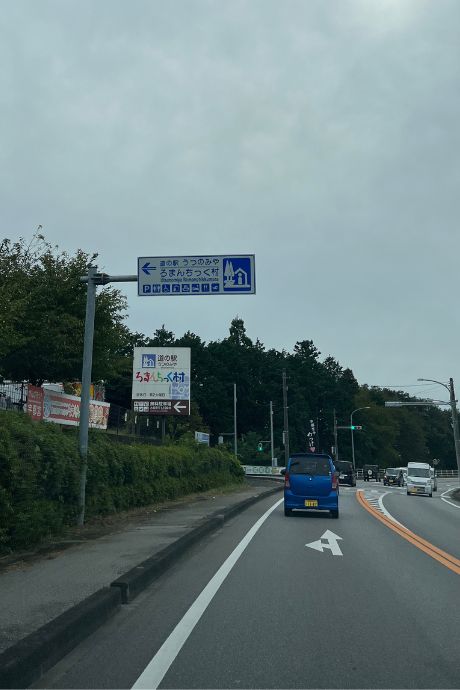
They do not show up automatically at lower resolution in the mapping apps, especially not Google apps. Also, they are not consistently named in Google either – sometimes the name first and then ‘roadside station’, other times ‘Michi no Eki’ first, then the name. And there are other formats for the name as well.
If you plan to visit a Michi no Eki, it helps to have its address in Japanese. Looking it up online can be tricky if you only know its name in English. Sometimes, even official names in English can lead you the wrong way.
If you speak Japanese (or understand it well enough to search by area), the official home page of the National Michi no Eki Association is very helpful. If not, try using Google Translate.
The administrator of the” Free Camping And Onsen In Japan” Facebook group James Oda has created a Google map that shows Michi no Eki all over Japan. However, the map was created in 2015 and does not appear to have been updated since then. It does not, for instance, contain the Sakai Michi no Eki.
Final Thoughts
As you drive through the roads of the Japanese countryside, stopping at a Michi no Eki is a rewarding experience. Many of these roadside stations offer not just amenities but also breathtaking views. They provide a deeper, more authentic glimpse of the location than most typical tourist spots.
At the bussankan and farmers markets, you’ll discover unique variations of familiar vegetables and dishes.
The restaurants serve local specialties, often at prices that are hard to beat—especially near the seaside. And while the tourist information at Michi No Eki is mainly in Japanese, it’s handy for travellers.
Frequently Asked Questions about Michi no Eki
The secret behind how Michi No Eki flourished across Japan mainly comes down to convenience, curiosity, and price. Convenience as in 24-hour toilets, and curiousity as in travellers eager to experience something new. And price as in cheap vegetables, thanks to cutting out the middleman. So let me answer some questions about what you should expect.
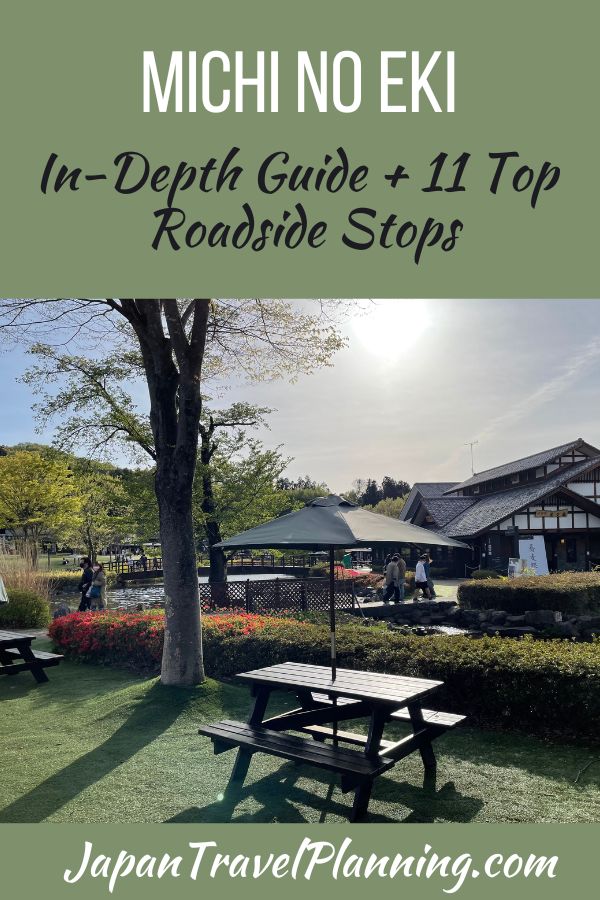
- Easy comparison of multiple car rental provider options using ToCoo!
- Use coupon code K49O12 to get your 1,000 yen discount
- ToCoo! is a local Japanese car comparison site that has the most options available
- Clear description of included protection and excess
- Good cancellation options
- Child seats, GPS, electronic toll cards, second driver and more are available as add-ons
You may also like:
Renting a Car In Japan: A Comprehensive Guide for Tourists
Renting a Car in Okinawa: Explore Japan’s Paradise
Driving in Okinawa Guide: Getting Around the Paradise Islands
Driving in Japan with Confidence: Read our Detailed Guide
International Driving Permit for Japan: Your Essential Guide
Japan Traffic Lights Guide: More Than Red, Yellow, and Green
Guide to Japan Road Signs: Navigate with Confidence
Michi no Eki: In-Depth Guide + 11 Top Roadside Stops
Navigating Japanese Highways: A Comprehensive Guide for International Drivers
Join the Japan Travel Planning Facebook Group or Discord Server
You are also welcome to join our Japan Travel Planning Facebook Group and our Japan Travel Planning Discord Server – they are great resources to enable you to ask questions about your upcoming trip to Japan!
Disclaimer: This article contains affiliate links. If you book after clicking on one of these links then we may receive a small commission at no extra cost to you.

